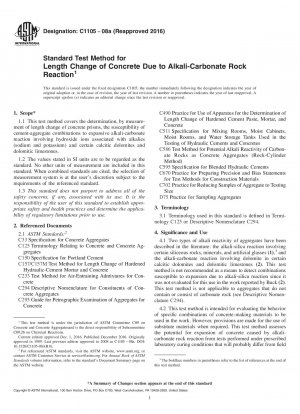ASTM C1105-08a(2016)
Standard Test Method for Length Change of Concrete Due to Alkali-Carbonate Rock Reaction
- Standard No.
- ASTM C1105-08a(2016)
- Release Date
- 2008
- Published By
- American Society for Testing and Materials (ASTM)
- Status
- Replace By
- ASTM C1105-23
- Latest
- ASTM C1105-23a
- Scope
4.1 Two types of alkali reactivity of aggregates have been described in the literature: the alkali-silica reaction involving certain siliceous rocks, minerals, and artificial glasses (1),3 and the alkali-carbonate reaction involving dolomite in certain calcitic dolomites and dolomitic limestones (2). This test method is not recommended as a means to detect combinations susceptible to expansion due to alkali-silica reaction since it was not evaluated for this use in the work reported by Buck (2). This test method is not applicable to aggregates that do not contain or consist of carbonate rock (see Descriptive Nomenclature C294).
4.2 This test method is intended for evaluating the behavior of specific combinations of concrete-making materials to be used in the work. However, provisions are made for the use of substitute materials when required. This test method assesses the potential for expansion of concrete caused by alkali-carbonate rock reaction from tests performed under prescribed laboratory curing conditions that will probably differ from field conditions. Thus, actual field performance will not be duplicated due to differences in wetting and drying, temperature, other factors, or combinations of these (see Appendix X1).
4.3 Use of this test method is of particular value when samples of aggregate from a source have been determined to contain constituents that are regarded as capable of participation in a potentially deleterious alkali-carbonate rock reaction either by petrographic examination, Guide C295, by the rock cylinder test, Test Method C586, by service record; or by a combination of these.
4.4 Results of tests conducted as described herein should form a part of the basis for a decision as to whether precautions be taken against excessive expansion due to alkali-carbonate rock reaction. This decision should be made before a particular cement-aggregate combination is used in concrete construction (see Note 1).
Note 1: Other elements that may be included in the decision-making process for categorizing an aggregate or a cement-aggregate combination with respect to whether precautions are needed, and examples of precautions that may be taken, are described in Appendix X1.
4.5 While the basic intent of this test method is to develop information on a particular cement-aggregate combination, it will usually be very useful to conduct control tests in parallel using the aggregate of interest with other cements or the cement of interest with other aggregates.
1.1 This test method covers the determination, by measurement of length change of concrete prisms, the susce......
ASTM C1105-08a(2016) Referenced Document
- ASTM C125 Standard Terminology Relating to Concrete and Concrete Aggregates
- ASTM C150 Standard Specification for Portland Cement
- ASTM C157/C157M Standard Test Method for Length Change of Hardened Hydraulic-Cement, Mortar, and Concrete
- ASTM C233 Standard Test Method for Air-Entraining Admixtures for Concrete*, 2024-04-20 Update
- ASTM C294 Standard Descriptive Nonmenclature for Constituents of Concrete Aggregates
- ASTM C295 Standard Guide for Petrographic Examination of Aggregates for Concrete
- ASTM C33 Standard Specification for Concrete Aggregates
- ASTM C490 Standard Practice for Use of Apparatus for the Determination of Length Change of Hardened Cement Paste, Mortar, and Concrete
- ASTM C511 Standard Specification for Moist Cabinets, Moist Rooms, and Water Storage Tanks Used in the Testing of Hydraulic Cements and Concretes
- ASTM C586 Standard Test Method for Potential Alkali Reactivity of Carbonate Rocks for Concrete Aggregates (Rock Cylinder Method)
- ASTM C595 Standard Specification for Blended Hydraulic Cements
- ASTM C670 Standard Practice for Preparing Precision and Bias Statements for Test Methods for Construction Materials
- ASTM C702 Standard Practice for Reducing Samples of Aggregate to Testing Size
- ASTM D75 Standard Practice for Sampling Aggregates
ASTM C1105-08a(2016) history
- 2023 ASTM C1105-23a Standard Test Method for Length Change of Concrete Due to Alkali-Carbonate Rock Reaction
- 2023 ASTM C1105-23 Standard Test Method for Length Change of Concrete Due to Alkali-Carbonate Rock Reaction
- 2008 ASTM C1105-08a(2016) Standard Test Method for Length Change of Concrete Due to Alkali-Carbonate Rock Reaction
- 2008 ASTM C1105-08a Standard Test Method for Length Change of Concrete Due to Alkali-Carbonate Rock Reaction
- 2005 ASTM C1105-08 Standard Test Method for Length Change of Concrete Due to Alkali-Carbonate Rock Reaction
- 2005 ASTM C1105-05 Standard Test Method for Length Change of Concrete Due to Alkali-Carbonate Rock Reaction
- 1995 ASTM C1105-95(2002) Standard Test Method for Length Change of Concrete Due to Alkali-Carbonate Rock Reaction
- 1995 ASTM C1105-95 Standard Test Method for Length Change of Concrete Due to Alkali-Carbonate Rock Reaction

Copyright ©2024 All Rights Reserved